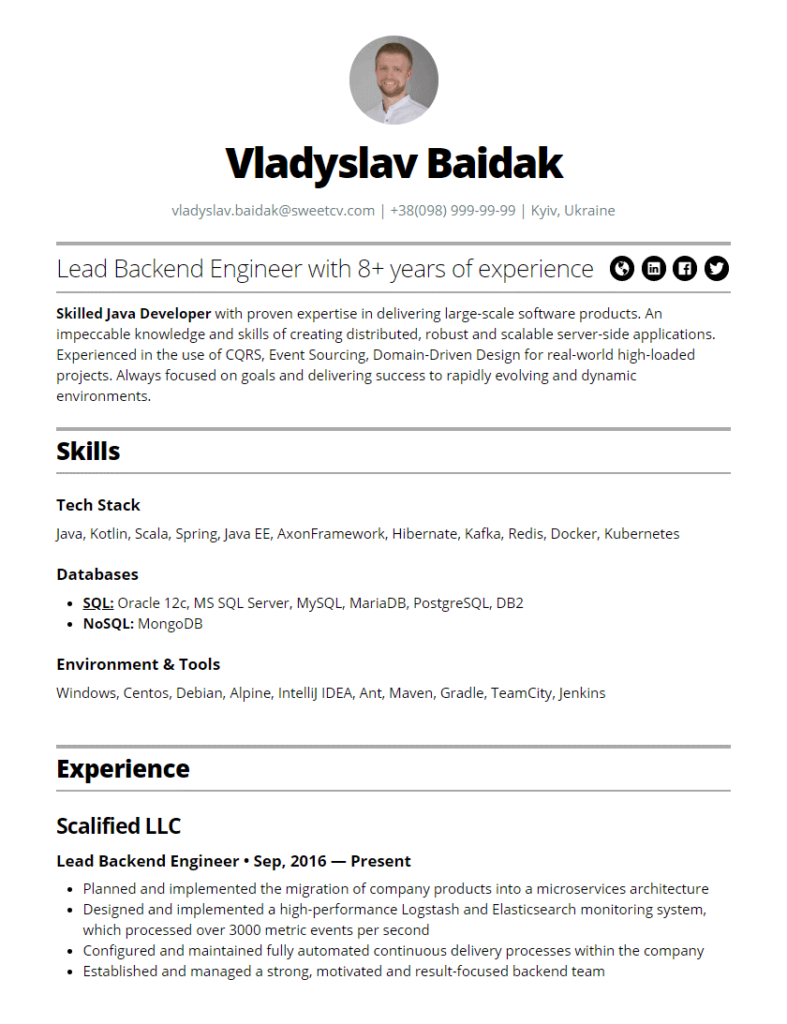A resume, or CV, is your first introduction to a potential employer. It should reflect all your strengths as a professional in your field. At first glance, creating a resume seems easy and straightforward, as there are many ready-made templates available online. However, if you want your resume to truly stand out among other applicants, it's important to know some secrets and nuances of creating a successful document. The best advice on what makes a good resume can be obtained from professional recruiters. They know all the rules and requirements for writing a resume and can point out the most common mistakes and offer solutions to them.
Resume types
If you are tasked with creating a resume for job placement, it is important to learn more about this document and its functions. Experts identify three main types:
- chronological;
- functional;
- combination.
You can choose any option, but remember that certain types of resumes are impractical for certain professions. To determine which type is best for you, it is necessary to study the features of each in more detail.

Chronological
A chronological resume is essentially a work biography, as it presents all the information about your education and professional experience strictly in chronological order. Such a description allows the company representative to evaluate how your career has developed and what you have achieved. It is important to note that career experience is presented in reverse chronological order, starting with your most recent job.
According to recruiters' advice, a chronological resume is best for people who have focused on one field and have achieved certain heights in it. It will also be advantageous for those whose last job was a position or company with a certain status and reputation in the business world. However, this type of resume may not be suitable for people who have not stayed long in their last positions, changed jobs frequently, or who want to change their field of activity in the future.
Functional
In this type of resume, work experience and employment periods are usually not specified or mentioned vaguely. Instead, certain blocks are presented that describe professional skills and acquired experience. These can include leadership qualities or organizational abilities, depending on the candidate and their experience. This approach allows for the evaluation of the person as a specialist and a future employee. However, employers are often wary of the lack of clear information about previous work experience.
Functional resumes are recommended for people who:
- are returning to the workforce after a long break;
- are applying for an entry-level position;
- their previous professional experience does not provide a complete understanding of their achievements and skills in the current field.
Thus, it can be particularly useful for project work or consulting. However, in all other cases, it is better to supplement the functional resume with a cover letter when submitting it.
Combination
This is the most optimal option, as it combines the advantages of both aforementioned types. Therefore, if you want to properly compose your resume, choose the combination version. It consists of two parts. The first part describes the candidate's skills and professional qualities, and the second provides a brief description of their work experience in chronological order. This way, the employer gets all the necessary information to evaluate whether the candidate is suitable for a specific position. The combination resume is currently the most popular option and is used most often in job searches. It should be noted that it is best suited for people with significant experience.

Principles of Writing the Perfect Resume
To write a resume that will interest a potential employer and present you in the best possible light, you need to put in some effort. To ensure success, it's important to evaluate whether it meets certain requirements.
- Informational. Be sure to include all information that may be of interest to a prospective employer. Depending on the position, indicate not only professional skills but also personal qualities.
- Truthfulness. It's important that all information provided in the resume corresponds to reality. After all, relationships between the company and the employee are based on trust, so starting employment with a lie is not worth it.
- Structure and conciseness. Information about yourself and your professional experience should be presented succinctly and in an organized manner. Reading continuous text is quite tiring, so a good resume should include lists, paragraphs, and other details that make information easier to perceive.
- Selectivity. Before writing a resume, analyze the information you plan to provide to the potential employer. Choose only what may be of interest to them.
- Addressing the reader. When reading the text, a person should feel that you are addressing them directly. This will generate interest and, accordingly, your chances of receiving a response to your resume will increase significantly.
- Positivity. Strive to ensure that the tone of the resume presents you as an active and self-confident person. Therefore, focus primarily on your achievements and strengths.
Content and Formatting Rules for a Resume
Although each resume is unique, it has a standardized structure that should be followed. This is important both when writing from scratch and when using a template. In any case, it is important to remember the presence of several key points.
Photo, Contact Information, and Place of Residence
This is where the introduction to the applicant begins in the resume. Therefore, after indicating your last name and first name, be sure to add a photo. Even if your appearance is not crucial for your position, the employer will appreciate seeing who they are dealing with. However, this is only advisable if you have a high-quality and appropriate photograph; otherwise, it is better to do without it.
Also, write your actual address, not forgetting the zip code. For job search purposes, you can create a separate email or use your personal one. It is desirable that it looks official and consists of your first and last name. In addition, it is customary to provide a mobile phone number, one or more messengers for communication, as well as links to professional social networks such as LinkedIn.
Desired Position and Salary
In this section, it's important to have the resume title match the desired position. It should be specific, such as "Procurement Manager" rather than just "Manager".
Don't be afraid to include salary information. If you don't have specific numbers, you can use the average market rate as a guide.

Work Experience
In this section, describe your previous work experience starting from your most recent job. Each item should include the name of the company, duration of employment, position, and responsibilities. It's important that your previous experience is relevant to the desired job or at least partially related to it. Therefore, it's important to describe these items in as much detail as possible. If there are significant gaps in your career, you should explain them, such as due to maternity leave or transitioning to freelance work.
Education
In this section, include the name of the educational institution you attended and the field of study. If you've completed specialized courses, such as in Photoshop, it's also worth including information about them.
Key Skills
First and foremost, you should list your hard skills or professional skills. This includes the programs you're proficient in, languages you know, and so on. It should all be directly relevant to the future position. You can also inform potential employers about your soft skills or social skills, such as communication, stress management, attention to detail, and so on. Make sure that they don't contradict each other, such as "analytical thinking" and "creativity"
About yourself
Write about your hobbies, interests, or volunteering. As experience shows, sometimes this point in the resume can play a decisive role, because such personal information often brings people together, even if it is purely about business relationships.
The main mistakes when creating a resume
Writing a truly perfect resume is a difficult task, especially for beginners. They often make mistakes that may seem insignificant, but can significantly spoil the first impression. To avoid misunderstandings in the future, we suggest familiarizing yourself with them:
- One resume for different vacancies. This is a fairly common mistake of people who want to save time. In fact, if you apply for different positions, be sure to create separate documents for each of them. This will save the recruiter time and allow them to evaluate your strengths necessary for a specific job.
- Using cliché phrases and banal expressions. Of course, no one canceled the business style, but if your resume is filled to the brim with monotonous words, it is unlikely to generate interest. You need to try to interest the recruiter and stand out among other candidates.
- Grammar and spelling mistakes. Even if the desired vacancy is not related to the work of a philologist, the resume should not contain typos. Therefore, before sending it, be sure to proofread it, and it is even better to show it to someone who knows the rules of Ukrainian language well.
- Inappropriate size. A short story will not give an opportunity to evaluate all your skills and experience. Instead, a resume that takes more than two pages is unlikely to be read.
- Lack of facts. People who dream of getting the desired offer often decorate their resume with too vague terms. In fact, the employer is not interested in how hardworking you are on paper, but he would not mind knowing, for example, how many press releases you have prepared.

Useful tips from recruiters
When creating a resume, applicants should listen to the advice of professional recruiters. After all, they review a large number of CVs every day and can say with confidence which options most often attract attention. In general, statistics show that HR specialists spend from 10 seconds to 10 minutes reading a resume. Therefore, unsuccessful options are eliminated very quickly. In order not to be among them, follow the following recommendations:
- When creating a resume, use the PDF format as it is the most convenient for viewing.
- Do not upload the document to Google Docs because users can see how many people are still viewing it.
- Format the resume in a consistent style, avoid using multiple fonts and colors.
- In today's world, it is considered impolite to mention your age, gender, marital status, or religion in your resume.
- In the IT industry, it is customary to submit a resume in English. This will allow you to showcase your English language skills.
- You can write a resume using special online services such as Cvmaker. However, it is best to customize them to fit your needs by removing or adding certain sections.
Cover Letter
The practice of adding a cover letter to a resume is quite popular. It gives more detailed information about the candidate and helps to convince the employer that he needs you. In the cover letter, you should introduce yourself, write what position you are applying for. If the company has several branches, then indicate in which one you would like to work. Briefly describe your advantages and skills as a future employee, demonstrate interest in the company's activities. The cover letter should not duplicate the resume, so it is recommended to show a little more creativity and ingenuity. However, there is no need to write too long texts, a maximum of one sheet. At the end, be sure to thank for paying attention to your candidacy.
A sample of a good resume in 2023
To write a successful CV, it is best to have a sample of a good CV in front of you. It will help to better orient yourself in what information needs to be specified, and will give an idea of how the finished work should look.


